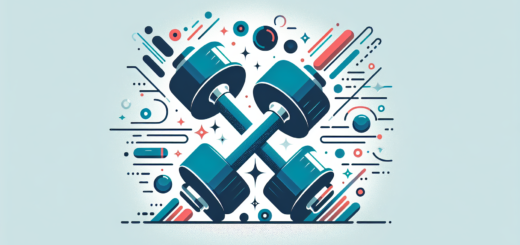10 Steps to Start Your Fitness Journey
Are you ready to embark on a journey to a healthier and fitter you? Look no further because we’ve got you covered with our 10 simple steps to start your fitness journey. From setting realistic goals to finding the right exercise routine for you, we’ll guide you through each step of the way, providing you with the tools and motivation you need to succeed. Whether you’re a beginner or someone looking to get back on track, these steps will help you kickstart your fitness journey and transform your lifestyle for the better. So, lace up your sneakers, put on your workout gear, and get ready to take the first step towards a healthier and happier you!

Setting Your Goals
Identify your fitness goals
When starting your fitness journey, it’s important to first identify your fitness goals. What do you want to achieve? Whether it’s losing weight, building muscle, improving endurance, or simply maintaining overall health, clearly defining your goals will provide you with a clear direction to follow.
Set realistic and measurable goals
While it’s great to have aspirations, it’s crucial to set realistic and achievable goals. Setting goals that are too ambitious may lead to disappointment and frustration. Consider your current fitness level and any limitations you may have. Additionally, make sure your goals are measurable so that you can track your progress and celebrate small victories along the way.
Create a timeline for achieving your goals
Once you have identified and set your goals, it’s essential to create a timeline for achieving them. Breaking down your goals into smaller milestones can help you stay motivated and focused. Whether it’s weekly, monthly, or quarterly targets, having a timeline will provide structure and help you stay on track.
Assessing Your Current Fitness Level
Evaluate your overall health
Before diving into any fitness program, it’s important to evaluate your overall health. Consult with a healthcare professional to assess any underlying medical conditions or concerns that may affect your exercise routine. Understanding your current health status will ensure you can tailor your fitness journey to your body’s needs and capabilities.
Assess your cardiorespiratory fitness
Cardiorespiratory fitness refers to your cardiovascular and lung health and fitness. Assessing your cardiorespiratory fitness level will help you determine your starting point and gauge improvements over time. You can do this by performing exercises such as jogging, cycling, or using cardio machines while monitoring your heart rate and how quickly you recover.
Measure your strength and muscular endurance
Strength and muscular endurance are vital components of fitness. Assessing these areas will help you determine your baseline and track progress. Simple exercises like push-ups, squats, and planks can help you evaluate your strength. Tracking the number of repetitions or the amount of weight you can lift will allow you to see improvements over time.
Evaluate your flexibility
Flexibility plays a crucial role in preventing injuries and improving movement quality. Take some time to assess your flexibility by performing stretches for different muscle groups. Pay attention to any tightness or limited range of motion. Regularly performing flexibility exercises can help improve your flexibility and reduce the risk of injuries.
Creating a Workout Plan
Choose activities you enjoy
One of the keys to sticking with a fitness routine is choosing activities that you genuinely enjoy. Whether it’s dancing, hiking, swimming, or weightlifting, finding activities that bring you joy will make it easier to stay motivated and committed to your fitness journey.
Decide on the frequency and duration of your workouts
To create an effective workout plan, decide on the frequency and duration of your workouts. Aim for at least 150 minutes of moderate-intensity aerobic activity or 75 minutes of vigorous-intensity aerobic activity each week. Additionally, include strength training exercises at least two days a week, focusing on all major muscle groups.
Include a mix of cardio and strength training exercises
Both cardiovascular exercise and strength training are essential for overall fitness. Cardio exercises such as running, cycling, or swimming help improve heart health and burn calories, while strength training exercises like weightlifting or bodyweight exercises help build and maintain muscle mass. Including a combination of both will help you achieve a well-rounded fitness routine.
Consider incorporating flexibility and balance exercises
In addition to cardio and strength training, don’t forget to incorporate flexibility and balance exercises into your workout plan. These types of exercises, such as yoga or tai chi, can improve mobility, stability, and prevent injuries. Adding these components will enhance your overall fitness and well-being.
Finding a Support System
Join a fitness community or gym
Being part of a fitness community or joining a gym can provide you with a supportive environment and access to professional guidance. It offers an opportunity to connect with like-minded individuals who can inspire and motivate you along your fitness journey. Additionally, gyms often provide a variety of classes and equipment to support your workout plan.
Get a workout partner
Having a workout partner can be highly motivating and make exercising more enjoyable. Find a friend, family member, or colleague who shares similar fitness goals and schedule regular workout sessions together. You can hold each other accountable, offer encouragement, and make the journey more fun and social.
Hire a personal trainer
If you’re new to exercise or have specific fitness goals, hiring a personal trainer can be a worthwhile investment. A qualified personal trainer can create a tailored workout plan, guide you through proper form and technique, and provide valuable knowledge and motivation to help you reach your goals safely and efficiently.
Seek support from friends and family
Even if you don’t have a workout partner or personal trainer, seeking support from friends and family is crucial. Share your fitness goals and progress with them and ask for their encouragement and support. Having a support system can provide you with the motivation and accountability you need to stay on track and overcome challenges.

Eating a Balanced Diet
Determine your daily caloric needs
Eating a balanced diet is a fundamental aspect of a successful fitness journey. Start by determining your daily caloric needs based on factors such as age, gender, weight, height, and physical activity level. Online calculators or consultations with a registered dietitian can help you determine the appropriate caloric intake for your goals.
Focus on consuming whole, nutrient-dense foods
To fuel your fitness journey, focus on consuming whole, nutrient-dense foods. These are foods that are minimally processed and provide a wide range of vitamins, minerals, fiber, and antioxidants. Include plenty of fruits, vegetables, lean proteins, whole grains, and healthy fats in your diet to ensure you’re getting the necessary nutrients for optimal performance and recovery.
Include a variety of fruits, vegetables, lean proteins, and whole grains
Aim to have a colorful plate by incorporating a variety of fruits, vegetables, lean proteins, and whole grains into your meals. Fruits and vegetables provide essential vitamins and minerals, while lean proteins help build and repair muscle tissue. Whole grains provide sustained energy and are a great source of fiber. Balancing these food groups will help you meet your nutritional needs.
Stay properly hydrated
Hydration is key for overall health and optimal performance. Make sure to drink an adequate amount of water throughout the day, especially during workouts. The exact amount varies for each individual, but a general guideline is to aim for at least eight cups (64 ounces) of water per day. Listen to your body’s thirst cues and adjust accordingly.
Tracking Your Progress
Keep a record of your workouts
Keeping a record of your workouts can be incredibly beneficial. Whether you prefer using a notebook, a fitness app, or an online tracking tool, recording your exercises, sets, reps, and weights allows you to track your progress and see how far you’ve come. It also helps you identify patterns, strengths, and areas to improve upon.
Take regular measurements and track changes
In addition to tracking your workouts, taking regular measurements can provide objective data of your progress. Measure your weight, body measurements, and body fat percentage at various intervals, such as monthly. This will help you see changes in your body composition and serve as tangible evidence of your hard work paying off.
Monitor your dietary intake
Alongside tracking your workouts, monitoring your dietary intake can be helpful in assessing your progress and ensuring you’re meeting your nutritional goals. Consider using a food diary app or tracking your macronutrients (carbohydrates, proteins, and fats) to ensure you’re consuming an appropriate balance for your fitness journey.
Utilize fitness apps or journals
There are many fitness apps and journals available that can simplify the tracking process. These tools often provide workout templates, nutrition logs, and progress charts, making it easier to stay organized and motivated. Explore different options and find one that suits your preferences and needs.
Staying Motivated
Set short-term goals to stay motivated
While long-term goals are essential, setting short-term goals can help you stay motivated along the way. Break your long-term goals into smaller, achievable milestones that you can celebrate more frequently. This gives you a sense of accomplishment and encourages you to keep pushing forward.
Reward yourself for achieving milestones
Rewards can be a powerful motivator. Treat yourself to something you enjoy when you achieve a milestone or reach a significant goal. It doesn’t have to be extravagant; it can be as simple as buying a new workout outfit, taking a spa day, or indulging in a favorite healthy meal. Recognizing and celebrating your achievements is an important part of staying motivated.
Find inspiration through success stories or role models
Drawing inspiration from success stories or role models can fuel your motivation. Read about others’ fitness journeys, watch documentaries, or follow fitness influencers who share their transformation stories. Seeing others achieve their goals can inspire you and remind you that you, too, have the potential to succeed.
Employ visualization techniques
Visualization is a powerful technique used by athletes and fitness enthusiasts alike. Take some time each day to visualize yourself reaching your fitness goals. Imagine how achieving those goals will feel and what it will look like. Visualizing success can help reinforce your motivation and make your goals feel more attainable.
Listening to Your Body
Pay attention to any discomfort or pain
Listening to your body is essential for avoiding injuries and ensuring long-term success. Pay attention to any discomfort or pain during your workouts. If something doesn’t feel right, modify the exercise or seek guidance from a professional. Push yourself, but also know when to rest and recover.
Practice proper form and technique
Proper form and technique are critical for effective and safe workouts. Prioritize learning and practicing proper form for each exercise you perform. If you’re unsure about the correct technique, consult a personal trainer or reputable online resources to ensure you’re maximizing the benefits and minimizing the risk of injury.
Take rest days to allow for recovery
Rest days are just as important as workout days. Schedule regular rest days in your fitness plan to allow your body time to recover and repair. Overtraining can lead to burnout and increased risk of injury. Listen to your body’s signals, and don’t hesitate to take a day off when you need it.
Modify your workouts as needed
Flexibility is key when it comes to working out. Adjust your workouts as needed based on how your body is feeling or any changes in your circumstances. If you’re tired or recovering from an illness, consider lowering the intensity or duration of your workouts. Adapting to your body’s needs will help you maintain consistency and avoid setbacks.
Overcoming Challenges
Identify and address potential obstacles
Throughout your fitness journey, you’ll likely encounter challenges or obstacles. Identifying these potential hurdles in advance can help you develop strategies to overcome them. Whether it’s lack of time, injuries, or struggles with motivation, brainstorm potential solutions and create a plan of action to address them head-on.
Plan for busy periods or travel
Life can get busy, and travel can disrupt your routine. Planning ahead for these scenarios can help you stay on track. Explore workout options in the area you’re visiting, pack portable fitness equipment, or utilize bodyweight exercises that can be done anywhere. Adapt and view these situations as opportunities to add variety to your workouts.
Find alternative ways to exercise
Sometimes your preferred exercise routine may not be feasible due to limitations or circumstances. Find alternative ways to stay active and incorporate physical activity into your daily life. Explore different workout classes, try outdoor activities, or engage in household chores that double as exercise. The key is to find activities that keep you moving and bring you joy.
Develop strategies for dealing with motivation slumps
Motivation can fluctuate throughout your fitness journey. It’s normal to experience periods of low motivation. Develop strategies to combat these slumps, such as trying new workout routines, enlisting the help of a workout buddy, or engaging in other forms of self-care to reignite your motivation. Remember why you started and focus on the long-term benefits of staying committed.
Celebrating Your Achievements
Acknowledge and celebrate your progress
Take time to acknowledge and celebrate your progress, no matter how small. Recognize your achievements along the way and appreciate the effort and dedication you’ve put into your fitness journey. Celebrate each milestone reached, as these accumulations of accomplishments will inspire you to keep pushing forward.
Share your accomplishments with others
Sharing your accomplishments with others can help reinforce your commitment and provide you with additional support and encouragement. Whether it’s posting about your progress on social media, discussing your achievements with friends and family, or joining online fitness communities, sharing your journey inspires others and invites positive energy into your life.
Set new goals to continue challenging yourself
After celebrating your achievements, it’s time to set new goals. Continually challenging yourself is vital for personal growth and maintaining long-term motivation. Reflect on your progress and identify areas you still want to improve upon or new fitness endeavors you’d like to explore. Setting new goals will keep you engaged, motivated, and excited about your ongoing fitness journey.
Embarking on a fitness journey is an exciting and transformative experience. By setting realistic goals, assessing your current fitness level, creating and following a workout plan, finding support, maintaining a balanced diet, tracking your progress, staying motivated, and listening to your body, you are well on your way to achieving the healthier, fitter lifestyle you desire. Remember to celebrate each accomplishment along the way and never forget that you have the power to shape your own fitness journey.

















It's great that you talked about how business insurance can provide financial protection against unexpected events and help ensure the…
I like that you mentioned how business insurance is essential for protecting your bottom line and the long-term viability of…